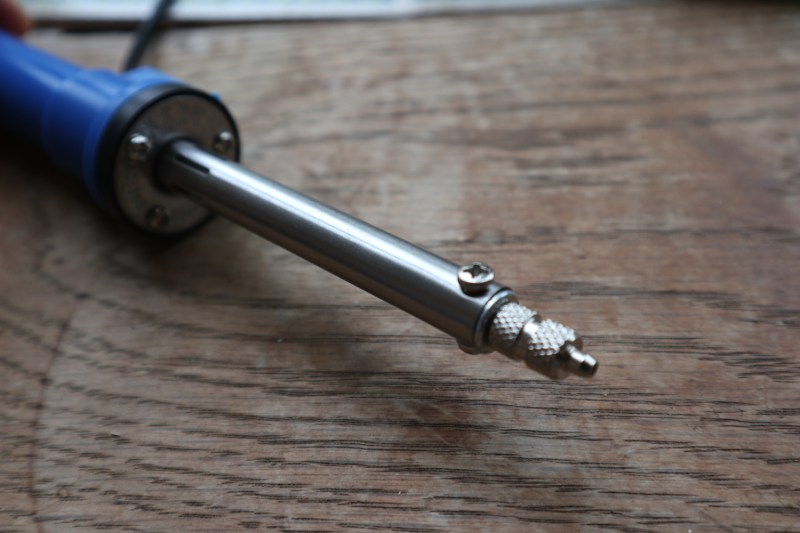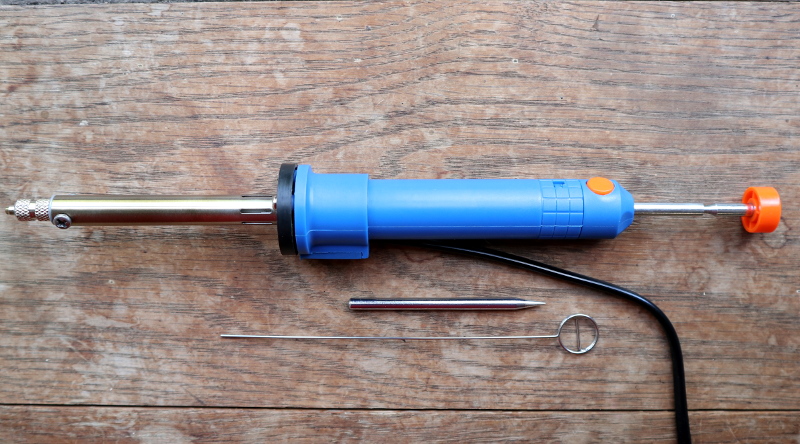Is the second cheapest tool you can find any better than the cheapest one?
Readers with long memories will recall there was a time when I amused myself by tacking inexpensive tools or electronic devices to my various orders from the Chinese electronic Aladdin’s Cave. Often these inexpensive purchases proved to be as disastrous or ineffective as you might expect, but sometimes they show unexpected promise, true diamonds in the rough. It’s been a while and life has intervened over the last year, but it’s time to resume this harmless diversion.
Memories Of An Explosive Conclusion
A particularly memorable review came in April 2018, when I bought a five pound ($6.30) desoldering iron. I described it then as an “unholy lovechild of a cheap solder sucker and an even cheaper soldering iron“, and while that was an accurate portrayal it also showed promise as a useful tool that would fill a niche in my requirements. Desoldering is always slightly annoying, and a heated desolder pump genuinely does make a difference. Unfortunately for me, the cheap desoldering tool was not a product I’d recommend that anyone try for themselves. A combination of questionable electrical safety and a propensity to explosively deconstruct itself meant it has languished unused in my big box of cheap junk, and I’m still without a decent desoldering solution. It is time to buy something better, and in the rich tradition of reviewing inexpensive stuff I decided to pick up the next cheapest desoldering iron I could find. Eight pounds ($10) secured me a Shi Yi Tool Sy365-8, and I set to on this review.
The unit arrived in a blister pack along with a wire tool for clearing its nozzle and a metal pointy thing whose intended use is unclear. All the information on the pack is in Chinese, but with Google Translate it was revealed to be nothing more than the usual descriptive text. The iron itself is similar to the previously reviewed model, something like a chunky take on a cheap soldering iron with the plunger and button of a spring-loaded desoldering tool protruding from the handle. It also has the same arrangement of the power cord emerging from the side of the handle below the element, and the same American-style NEMA mains plug.
Commenters assured me last time that in China this is sometimes used as a 230V connector, however for UK mains I put a BS1363A plug on it.
Extra Insulation Gives Confidence

Examining it more closely it was clear where at least some of my extra three quid had gone. The element and tip look very similar to those on the cheaper iron, but where the previous one’s mains cable had entered without sleeving right against the hot metal base of the element, this one has an extra insulating collar between handle and metalwork. It doesn’t have a double-insulated symbol anywhere on it, but unlike the other model it gives me confidence in its 3A twin wire no earth mains cable.
In use, the iron performed exactly as expected. A heated solder sucker is an effective tool, able to more efficiently remove solder than a separate iron and sucker. It smoked a bit on first use due to oil from manufacturing and it could use a bit more power than the quoted 36W because large joints needed a bit of time to get the heat into them, but otherwise it’s exactly the desoldering tool I expected for my 8 quid.
Will It Blow? Or Will It Suck?

So to the most important paragraph of the whole review, the one with the answer to the question you’re all asking. Did this tool explosively deconstruct itself as its cheaper competitor had? That solder sucker had been fixed together by friction alone, its piston was a push-on fit, and a bit of usage had dislodged it. I’m pleased to say that this one appears to have a different design with a secure cap over the top of the piston, and try as I might I couldn’t launch its plunger off across the room.
In conclusion then, the Shi Yi Tool Sy365-8 desoldering iron is an effective tool for its size and power rating that appears to have been designed with some thought to electrical safety and which seems well-enough assembled that it remains in one piece during repeated use. It won’t replace your high-end desoldering station, but it’s a handy bench tool for the occasional desolderer.



















“and it could use a bit more power than the quoted 36W because large joints needed a bit of time to get the heat into them,”
Here at work (with a “professional” Hakko soldering station) I will often “double up” on larger joints, using a regular soldering iron, either right beside the desoldering nozzle, or on the opposite of the circuit board to dump more heat into the joint.
The desoldering unit appears to have its heating element farther away from the tip than the regular iron, and the nozzle has a larger contact area to heat up.
I would really like to know how HaD reader [Clara] does her(?) work, a previous comment indicated by her mentioned solder/desolder skills beyond my puny ones.
By that I meant “A large capacitor had me holding the iron on the joint for about a minute”.
Could it be the pointy thing is intended to be a regular soldering tip?
Yes. On Banggood it states:
“Package includes :
1 x 220V 36W SY365-8 Electronic Soldering And Desoldering Tool
( It will aslo come with a suitable adapter according to your country :)
1 x Fine iron wire (Used to clean welding stain easily)
1 x Welding iron sharp head”
“(Used to clean welding stain easily)”
The “stain” left in your chair after getting a jolt of mains voltage from the tool?
B^)
DAMHIKT
I’ve got a slightly different version of one of these — it says Jie la hua 099 on one label, and SHANG HAI Q.L. ELECTRIC IND.CO..LTD (sic) moulded into the case. The plunger mechanism’s in a plastic shroud so there’s less chance of plunging oneself in the face by mistake, but like the Cheapest there’s a gap and some worrying wires between the element and the plastic case. (It’s clearly the same element.) The mains connector has no earth wire but there’s a trailing earth wire with a crocodile clip on it. It cost me CHF 8.93 delivered.
It’s… great? By which I mean that it’s obviously as dodgy as hell, but it’s incredibly effective and has made the difference between an hour of swearing or a fifteen-second job. For something so simple it works really well. I haven’t yet figured out where the solder _goes_, because it never seems to come out again, so I’m expecting that one day it’ll just gum up with old solder, but I’ll deal with that then.
However, the next time I go to my local DIY shop I should buy a plug-in RCD for use with it, which should (help) protect me from mishaps caused by poor insulation. And I’m not ordering _that_ from Banggood.
I bought one of the jie la hua ones like you did and yes it’s great but the quality and safety of the unit was drawn into question when I noticed the the blue and brown wires were pulling free from the supposed cable grip. On further investigation I discovered that the nains cable was simply and badly just twisted to the wires coming from the element of the iron. I obviously dived this by soldering the wires and insulating them using shrink wrap tubes. Surely the manufacturer could have gone the extra step to ensure the safety of this unit.
After thinking about it I think that the twisted-together wires might be intentional. The wires going to the element are some exotic metal, maybe aluminium? I was unable to get solder to stick to them. They are actually twisted together pretty robustly and make good contact. It’s possible that this is actually the intended may to make connections for this use case. I would have wanted more strain relief and probably some heatshrink over the cable itself, however…
That plug scares me. I can’t think of any countries that use a US-style plug and run at 230. But then, you’d think the extra push would make it heat up quite nicely…
Australia has a very similar one. It is earthed, though.
I believe it’s common across a lot of Asia, especially where people are expected to have a mix of devices, or there’s a mix of voltages across a country. I think I saw a triple U.K./EU/US socket (all at 240v, unknown Hz) in China.
Eye popping design! Most of these can have a suction bellows and hose hooked up for faster action. The difference is like between a muzzle loading flintlock and a full auto recoil-less tool.
Having had to do through hole rework on thousands of units, I’ve always had at least “medium” tools for desoldering. I started with a Xyntronic 968 analog station, then a Xytronic LF853 and currently a Pace MBT301 w/ SX100. I’ve also made quite a bit of use fro a Hakko “gun” style desoldering unit that a friend owned. I couldn’t imagine going back to cheap shit. Having a unit with a vacuum pump is really the big deal. The Xytronic 968, Hakko were about on par with each other but the lead-free Xytronic and Pace both have some serious heat (100W?) and can do pretty much any joints without help from a soldering iron. I would be very curious to see what the cheap end of the spectrum with an integrated vacuum pump could offer. In my experience, all of the units that had pumps were at least usable on a different layer than bulbs/spring loaded stuff.
I’m going to confess, I didn’t know this was a thing… a solder sucker + iron? genius, beats the pants off “heat the joint, then quickly throw the sucker over it and hope you get it all in time”
Especially with lead free solder,
that stuff solidifies before you remove the iron.
(sarcasm)
I have a Radio Shack version of this tool.
When purchased, I bought a couple of replacement tips.
My daughter clipped the power cord with a pair of scissors, I had to disassemble it to repair the cord.
(no, it wasn’t plugged in when she cut it!)
I tend to use a croc-clip with something heavy on the other end (e.g. reel of solder). Clip it round the component, turn the board upside down, heat the pads, and let gravity do the work. Then remove the excess solder with braid afterwards.
Don’t recommend it, but it works for the amount of desoldering I do.
https://www.banggood.com/8Pcs-Stainless-Steel-Hollow-Needles-Core-Desoldering-Tool-Set-p-928740.html?rmmds=search&cur_warehouse=CN
Unearthed cable? You really should do an insulation test. Brymen makes some nice meters with the required feature. An improvised test would be to put mains between the metal and the shorted connector and see if current flows. Be careful.
I ordered one from Banggood after reading this article. It arrived today (not bad, two weeks!).
Dug up some trashed PCB’s and started testing. Works like a charm. Should have had this years ago. Would have saved time, burned fingers, frustration, expletives, lifted pads, etc…
Jenny, I bought one and so far it’s been great. Thanks for the tip off.